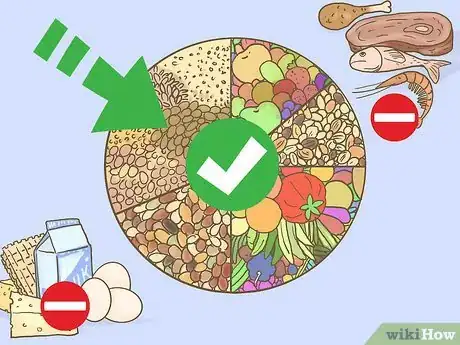This article was co-authored by wikiHow Staff. Our trained team of editors and researchers validate articles for accuracy and comprehensiveness. wikiHow's Content Management Team carefully monitors the work from our editorial staff to ensure that each article is backed by trusted research and meets our high quality standards.
There are 10 references cited in this article, which can be found at the bottom of the page.
wikiHow marks an article as reader-approved once it receives enough positive feedback. In this case, 84% of readers who voted found the article helpful, earning it our reader-approved status.
This article has been viewed 61,401 times.
Learn more...
Animals brighten our world and can make for amazing companions, but many animals are treated cruelly and unfairly all over the world. Fortunately, there are ways to make a difference and become animal friendly. You can stop supporting companies that make products with animal fur or test their products on animals. Changing your diet is another way to become more animal friendly and, in doing so, you can look after your own health as well!
Steps
Changing Your Dietary Habits
-
1Become a vegetarian and choose alternatives to meat. If you take meat out of your diet, you’ll need to find other ways to get proteins. Fortunately, there are plenty of options! Buying baked beans, chickpeas, or kidney beans is one method, while purchasing veggie burgers or sausages is another way to go.[1]
- Tofu, which is made from soy beans, is a great substitute for meat.
- You can still eat eggs and other dairy products if you become a vegetarian.
-
2Go vegan to cut all animal products out of your diet. Not only do vegans not eat meat, they don’t consume any dairy products at all. A well-mapped out vegan diet is healthy for people of all ages and backgrounds and provides all the nutrients your body needs.[2]
- Going vegan improves your diet and gives you room to try health-promoting options like fruits, nuts, and vegetables.
Not only is going vegan a great way to keep yourself healthy, it is fantastic for the environment as well. Avoiding all animal products will lower your carbon footprint.
Advertisement -
3Avoid local cuisine when traveling if it includes wild animals. If food items include endangered animals or involve inhumane production, stay away from them. One example is bushmeat, which comes from animals hunted in the wild for food.[3]
- Along these same lines, never buy souvenirs made from wild animals. Fur, ivory, teeth, and shells are some of the things used to make these trinkets.
Supporting Animal Rights
-
1Don’t purchase fur-based products. Many articles of clothing and blankets are made from real animal fur, but there are plenty of alternatives available. In fact, many brands and stores market themselves as anti-fur and sell their products based on this philosophy.[4]
- Valid fur alternatives include different types of fibers, such as a polyester-cotton mix.
-
2Stop buying products that test on animals. Numerous cosmetics, household, and personal care products are tested on animals, but many are not. The Leaping Bunny is a guide that lists cruelty-free brands which have met a rigorous, internationally recognized standard. Look for the Leaping Bunny logo on the packaging of some of these products.[5]
- Not every cruelty-free brand has the Leaping Bunny logo, so check to see if there is a different label that mentions that the brand doesn’t test on animals.
-
3Attend meetings with other animal rights activists. Check to see if your area has a local SPCA (Society for the Prevention of Cruelty to Animals) chapter and reach out to one of the current members. Many of these organizations do fun activities, like 5Ks, to raise money and awareness for animal rights.[6]
- This is a great way to become friends with like-minded people whom you might not have met otherwise!
Tip: If your schedule is too full for you to attend meetings regularly, consider making a donation to your local SPCA chapter.
-
4Never pay to take your picture with or ride wild animals. Many of these creatures have been taken from their homes and treated harshly so they’re docile around tourists. In some cases, these animals will be drugged and have their teeth removed.[7]
- Another example of this is swimming with dolphins. While it may seem like a fun, educational exercise, it’s unnatural and stressful for the animals.
-
5Recycle constantly to help protect the environment. Recycling paper, plastic, metal, glass, and other things is a great way to make sure none of it becomes pollution. One of the best ways to make sure animals have safe habitats is to keep them trash-free. When you go to buy food products, look for items sold in recyclable materials.[8]
- The beauty of becoming a vegetarian or going vegan is that you stop buying so much processed food and therefore have less trash to throw out!
Helping Mistreated Animals Directly
-
1Volunteer at a local animal shelter. Volunteering is a fairly large time commitment, but worth it for many people. Contact your local animal shelter to see if they need any help. You may be required to fill out an application, attend training sessions, and sign a liability waiver. Each shelter has different rules and regulations when it comes to volunteers.[9]
- Responsibilities can include walking the animals, showing the pets to potential adopters, and doing cleaning the shelter.
Tip: Some of these positions are actually paid, so if you have some free time and want to make some money while working towards a good cause, see if this is possible at your local shelter.
-
2Encourage your friends to volunteer with you. It will make the work that much more enjoyable and give you and your friends a chance to do something productive with your free time. If you’ve already started volunteering, ask your supervisor if your friends can come in and get started.[10]
- Most animal shelters need extra hands, so asking the shelter if your friends can join you shouldn’t be a problem.
- Animal shelters do require a good chunk of your time, so only ask friends who have the hours to commit to the job.
-
3Adopt a pet from an animal shelter to give it a new home. You can choose from cats, dogs, birds, and many other animals to give one a new life in a loving home. Most pets are actually moved to shelters because previous owners simply couldn’t keep them. This means that a lot of pets at shelters are family-ready and won’t cause big problems once they come home.[11]
- The adoption fee includes the cost of vaccinations, spay/neuter surgery, and other necessities.
- Make sure you’re financially stable and ready to take on this commitment. The last thing anyone wants is for an animal to go to an owner who can’t properly care for it. That said, pets adopted from shelters typically cost less than pets purchased at a store.
- Don’t be afraid to keep in touch with the shelter where your pet came from, as these people know the animal well and are more than happy to help.
-
4Report suspected animal cruelty to the proper authorities. Cruelty can come in the form of neglect or abuse. Some animals are abandoned, others aren’t given proper medical care, and a large number of animals are simply mistreated physically. If you see this happening or are aware of it, contact your local animal control agency or dial 9-1-1 and have them get in touch with the right people.[12]
- If you see an abandoned animal, don’t just immediately go up to it, as it could be infected or aggressive. Call the authorities right away so a professional can handle the situation.
References
- ↑ https://www.vegsoc.org/info-hub/going-veggie/
- ↑ https://www.vegansociety.com/go-vegan/why-go-vegan
- ↑ https://www.worldanimalprotection.org.uk/protect-animals/our-guide-to-animal-friendly-travel
- ↑ http://www.animalfree.info/en/what-to-wear.html
- ↑ https://www.humanesociety.org/resources/keep-animal-testing-out-your-shopping-cart
- ↑ https://www.pspca.org
- ↑ https://www.worldanimalprotection.org.uk/protect-animals/our-guide-to-animal-friendly-travel
- ↑ http://www.recycling-guide.org.uk/recycle.html
- ↑ https://www.petful.com/animal-welfare/getting-started-as-a-volunteer/









































































